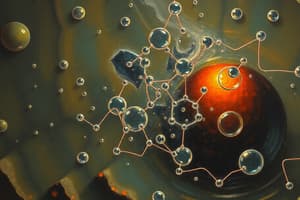Podcast
Questions and Answers
Which of the following best describes valence electrons?
Which of the following best describes valence electrons?
- They influence the atomic mass of an element.
- They determine the isotopic composition of an element.
- They are found in the innermost electron shell.
- They participate in ionization processes. (correct)
What is the significance of protons in an atom?
What is the significance of protons in an atom?
- They are responsible for the chemical bonding of the atom.
- They represent the energy levels of the atom.
- They define the identity of the element. (correct)
- They determine the mass number of the atom.
How is an anion formed?
How is an anion formed?
- By the loss of one or more neutrons.
- By the gain of one or more electrons. (correct)
- By the transfer of one or more protons.
- By the equal sharing of electrons.
What is the role of electronegativity in chemical bonding?
What is the role of electronegativity in chemical bonding?
Which subatomic particle has a negligible mass compared to protons and neutrons?
Which subatomic particle has a negligible mass compared to protons and neutrons?
How does the atomic mass of an element differ from its atomic number?
How does the atomic mass of an element differ from its atomic number?
What happens during the ionization of an atom?
What happens during the ionization of an atom?
Which of the following is true regarding isotopes?
Which of the following is true regarding isotopes?
Flashcards are hidden until you start studying
Study Notes
Atomic Structure
- Understanding chemistry is fundamental to biology; interactions among atoms are the basis of biological organization.
- Key elements in life include oxygen (O), nitrogen (N), carbon (C), and hydrogen (H), which together constitute about 96% of living matter.
- Essential elements also include potassium (K), sulfur (S), phosphorus (P), calcium (Ca), sodium (Na), chlorine (Cl), and magnesium (Mg), while trace elements are present in minute amounts (3.7%).
Characteristics of Atoms
- Atoms consist of three main subatomic particles:
- Protons (positively charged)
- Neutrons (neutral)
- Electrons (negatively charged)
- One Dalton (the unit of atomic mass) is equivalent to 1.67 x 10^-24 grams.
- Atomic number indicates the number of protons; atomic mass (or mass number) is the sum of protons and neutrons.
Electrons, Orbitals, and Electron Shells
- Electron orbitals represent the regions around the nucleus where electrons are likely to be found.
- Electron shells are layers around the nucleus that can hold electrons with specific energy levels.
- Valence electrons are those in the outermost shell, which play a critical role in chemical bonding.
Ions, Ionization, and Isotopes
- Ions are charged atoms that result from the loss or gain of electrons; ionization refers to this process.
- Anions are negatively charged ions (gained electrons), while cations are positively charged ions (lost electrons).
- Isotopes are variants of elements that have the same number of protons but different numbers of neutrons; radioisotopes are unstable isotopes that decay over time.
Bonding and Electronegativity
- Atoms tend to react and form chemical bonds to achieve a filled valence shell.
- Chemical bonds may form compounds or molecules, defined by their molecular formulas or structural formulas.
- Electronegativity measures an atom's ability to attract electrons; significant differences in electronegativity between two atoms lead to electron transfer and bond formation.
Ionic and Covalent Bonds
- Ionic bonds occur when one atom (with lower electronegativity) transfers an electron to another atom (with higher electronegativity), resulting in charged ions.
- This transfer influences the stability and reactivity of atoms, playing a crucial role in the formation of compounds.
Studying That Suits You
Use AI to generate personalized quizzes and flashcards to suit your learning preferences.




